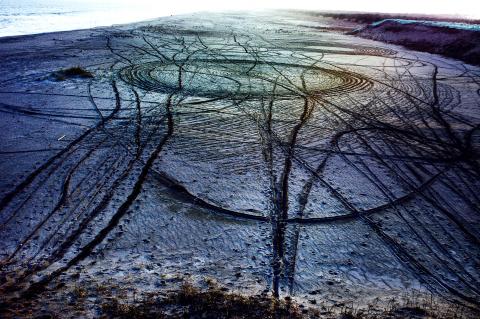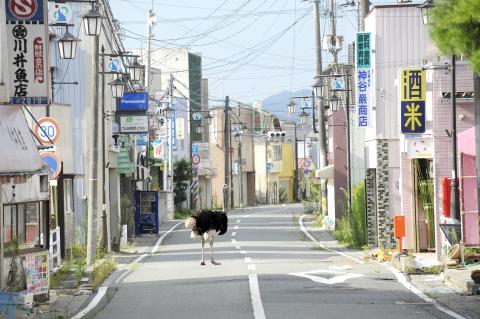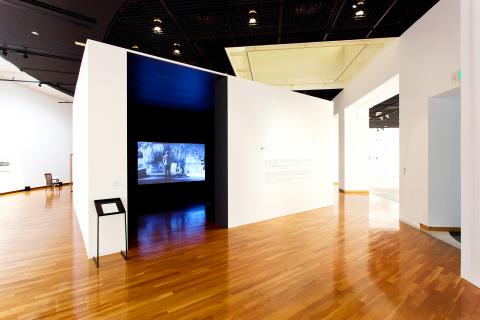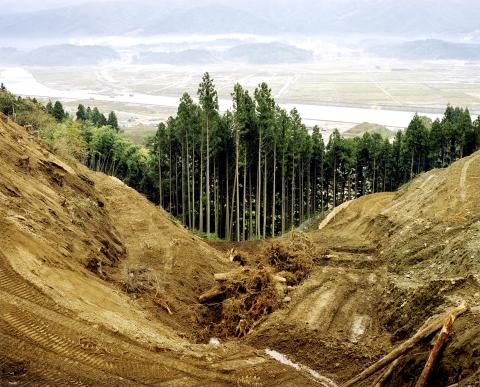Yukie Kamiya does not seem too shocked when I mention I have not visited the Japan Society Gallery in New York despite having lived in the city for a number of years.
“We have to do a better job at reaching out to other audiences,” jokes the recently appointed gallery director.
Kamiya is all smiles when we meet at a coffee shop near the Taipei Fine Arts Museum last week, marveling over its snazzy industrial decor and the shop owner’s well-groomed white-and-brown cat.

Photo courtesy of Museum of Fine Arts, Boston
She says one of her main goals is to promote Japanese art from a more global perspective. Having faced a similar challenge at her previous position as chief curator at the Hiroshima City Museum of Contemporary Art (Hiroshima MoCA), she understands that it will take time.
“Hiroshima is always seen as a city of trauma, but it is not just a victim,” Kamiya tells me. “Many people fail to remember that historically, Japan was also a perpetrator.”
Kamiya says she wanted to offer something more than art about the atomic bomb, so she included work by artists from other parts of Japan. Similarly, Kamiya hopes to showcase more non-Japanese artists at the Japan Society Gallery in New York so that viewers can learn about how individuals from other cultures perceive the East Asian nation.

Photo courtesy of Museum of Fine Arts, Boston
“The idea is to show Japanese-ness from other angles,” Kamiya says.
‘DISCORDANT HARMONY’
It is fitting that Kamiya’s latest curatorial project, Discordant Harmony, deals with the theme of traversing boundaries. The touring exhibition, which was initiated by the Goethe Institute in Seoul, features artists from Hong Kong, Taiwan, China, Japan and South Korea. It is currently on display at Hiroshima, MOCA and will make its final stop at Taipei’s Kuandu Museum of Fine Arts in July.

Photo courtesy of Kazuhiro Uchida
“The exhibition is more about understanding than it is about harmony,” says Kamiya of the exhibition’s oxymoronic title.
Kamiya, who is one of the four co-curators (the other three being from Taiwan, China and South Korea), adds that it has been an interesting collaboration. Not only do the artists and curators use English — which, for most of them, is their second language — to communicate, but by working together, they have also become more aware of and appreciative of the differences among countries in East Asia.
The exhibition posits that “Asia” is primarily a European construct, but in reality, the continent is defined by conflicting interests rather than a sense of a unified cultural community. Over the last few decades, power relations within the continent have shifted dramatically, from Japan colonizing Taiwan and South Korea to China flexing its economic muscle over the rest of Asia.

Photo courtesy of Museum of Fine Arts, Boston
“The role of the victim and the country in power is always changing,” Kamiya says.
She adds that it is interesting to see how South Korean dramas have become very popular in other Asian countries. For her, this shows how the soft power of popular culture can be a highly effective way of disseminating ideas. Likewise, art can also be used as a way to foster understanding.
One artist who gets this is Teng Chao-ming (鄧兆旻). The Taipei-born Teng, whose previous work has focused on the intersection between politics and political culture, does not shy away from bold statements. At the heart of Taipei Olympics 2024 (working title) is the idealistic belief held by the protagonist that Taipei will one day host the Olympics, just as Tokyo, Seoul and Beijing have done so in the past. While stressing the message of harmony, implicit in the artwork is the fact that Taipei cannot host the Olympics until Taiwan is recognized as a nation.

Photo courtesy of Museum of Fine Arts, Boston
Hong Kong artist Lee Kit (李傑), who is based in both Hong Kong and Taipei, takes a different approach by depicting working-class domestic simplicity in his installations.
Other works featured in Discordant Harmony touch on the links between Taiwan’s Sunflower movement and Hong Kong’s Umbrella Revolution.
‘IN THE WAKE’
It is a busy time for Kamiya as she will be back in New York for the opening of the Japan Society Gallery’s upcoming exhibition next month. Organized by the Museum of Fine Arts, Boston, In the Wake is focused solely on Japan, although it too should resonate with a global audience. The exhibition, which opens on March 11 to commemorate the fifth anniversary of the Tohoku earthquake and tsunami, features 17 Japanese artists and their personal responses to the disaster.
The more than 90 photographs, videos and installations are striking in their depiction of raw human emotion. The majority of the artists delve deep, revealing the direct effects the Tohoku disaster had on them or on certain communities while also critiquing the systemic flaws that were revealed in the wake of the government’s response to the tragedy — a sentiment that will certainly no be lost on those with direct experience of the recent earthquake in Tainan.
“Anyone can relate to the exhibition as it deals with how people respond to natural disasters,” Kamiya says.
Naoya Hatakeyama puts forth a particularly riveting before-and-after photography display. A Tohoku region native, Hatekeyama was in Tokyo when the tsunami hit. He hopped on a motorcycle — the only viable form of transportation given the circumstances — and spent the next three days driving home. Upon his arrival, he learned that he had lost his mother as well as his childhood home to the tsunami. What is striking is that while his video installation filmed before the disaster is somewhat sentimental, his photographs capturing flying debris and barren mountains boast a resolute stillness that is at once detached and introspective.
Lieko Shiga provides another fascinating before-and-after look into the disaster. Originally from an urban area in Aichi Prefecture, she was drawn to the beauty of the Tohoku region (especially the pine trees that dotted the beach) and relocated there before the disaster. Shiga made friends with the local villagers and photographed their daily life. She narrowly escaped the tsunami, although a lot of people she knew lost their lives on that day. The sense of loss and disbelief is evident in the “after” photography, especially in the Spiral Shore series which depicts vast stretches of land once covered by pine trees as being both apocalyptic yet beautiful.
Kamiya hopes that both exhibitions in Asia and New York will help viewers realize the power of art in highlighting the type of society we live in.
“Art is not just about beauty, it’s also about offering discussion about socio-political issues,” Kamiya says.

April 28 to May 4 During the Japanese colonial era, a city’s “first” high school typically served Japanese students, while Taiwanese attended the “second” high school. Only in Taichung was this reversed. That’s because when Taichung First High School opened its doors on May 1, 1915 to serve Taiwanese students who were previously barred from secondary education, it was the only high school in town. Former principal Hideo Azukisawa threatened to quit when the government in 1922 attempted to transfer the “first” designation to a new local high school for Japanese students, leading to this unusual situation. Prior to the Taichung First

Chinese Nationalist Party (KMT) Chairman Eric Chu (朱立倫) hatched a bold plan to charge forward and seize the initiative when he held a protest in front of the Taipei City Prosecutors’ Office. Though risky, because illegal, its success would help tackle at least six problems facing both himself and the KMT. What he did not see coming was Taipei Mayor Chiang Wan-an (將萬安) tripping him up out of the gate. In spite of Chu being the most consequential and successful KMT chairman since the early 2010s — arguably saving the party from financial ruin and restoring its electoral viability —

The Ministry of Education last month proposed a nationwide ban on mobile devices in schools, aiming to curb concerns over student phone addiction. Under the revised regulation, which will take effect in August, teachers and schools will be required to collect mobile devices — including phones, laptops and wearables devices — for safekeeping during school hours, unless they are being used for educational purposes. For Chang Fong-ching (張鳳琴), the ban will have a positive impact. “It’s a good move,” says the professor in the department of

Article 2 of the Additional Articles of the Constitution of the Republic of China (中華民國憲法增修條文) stipulates that upon a vote of no confidence in the premier, the president can dissolve the legislature within 10 days. If the legislature is dissolved, a new legislative election must be held within 60 days, and the legislators’ terms will then be reckoned from that election. Two weeks ago Taipei Mayor Chiang Wan-an (蔣萬安) of the Chinese Nationalist Party (KMT) proposed that the legislature hold a vote of no confidence in the premier and dare the president to dissolve the legislature. The legislature is currently controlled